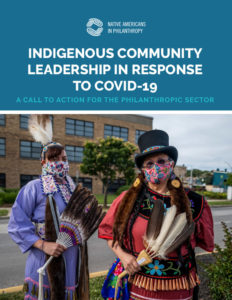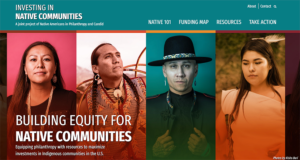5 Ways Philanthropy Can Better Invest In Indian Country
5 Ways Philanthropy Can Better Invest In Indian Country
 The following is adapted from our “Indigenous Community Leadership in Response to COVID-19: A Call to Action for the Philanthropic Sector” report.
The following is adapted from our “Indigenous Community Leadership in Response to COVID-19: A Call to Action for the Philanthropic Sector” report.
For too long, philanthropy in tribal communities has been driven by a desire to fix problems and define communities by their needs and deficits, not their strengths.
This charity approach to philanthropy is not only misguided, but also traps tribal communities in a false narrative they do not define for themselves and can often harm communities. Indigenous communities are comprised of rich cultures and nations and we are so much more than a perpetual crisis.
In our recent report, we showcase how Indigenous communities relied on their own strengths to spring to action, invite philanthropy to change their approach, and invest their resources quickly to respond to the COVID-19 pandemic.
Here are “5 Ways Philanthropy Can Better Invest in Indian Country":
1. Invest in Indigenous-led organizations and initiatives
One of the primary reasons we developed this report was to shine a light on the important role of Indigenous community leadership in meeting the many challenges in this pandemic. Especially in disasters and crises, funders too often prioritize speed and familiarity with intermediary partners that do not always represent the communities they’re trying to reach, including Indigenous communities.
2. Maximize general operating support
Many funders were quick to change the existing terms of their funding arrangements or distribute new funds without restrictions during this pandemic. This shift was crucial to Indigenous-led organizations across the country that needed the flexibility to meet needs in a fast-moving situation. We call on funders to maximize unrestricted and general operating support as a long-term strategy because it shifts power to the leaders who know how to best serve their communities and provides a more sustainable future for their organizations and initiatives.
3. Diversify vehicles for investment
The over $8 million invested in response efforts through the GoFundMe platform carries with it an important lesson for the broader philanthropic sector. Philanthropy’s traditional vehicles and structures to move money do not work for the diverse range of organizations, initiatives, and mutual aid networks that organized to meet the ongoing challenges of COVID-19. We analyzed GoFundMe as one clear example of community leaders acting quickly and locally while leveraging their personal networks. As we learned from community leaders, dollars need as many avenues as possible to get to the ground through trusted community partners.
4. Invest in Indigenous community strengths and leadership—not their deficits
Indigenous communities face a number of structural barriers to success while struggling with historical trauma. Though these are important challenges to understand and acknowledge, they should not define the hundreds of rich and diverse tribal cultures across the countries. Focusing on these deficits also ignores some of their most important resources and strengths, drawn from their cultural power. We call on funders to identify where they are investing through a deficit framework and shift to a strengths-based framework. NAP has developed The Indigenous Lifecourse framework to help guide funders in this process. We are also in the process of developing a new toolkit with practical strategies to achieve this shift in approach to be more in-line with an Indigenous worldview. NAP and Candid have also developed an Investing in Native Communities platform that provides additional resources and a map to explore funding to tribal communities.
5. Invest in tribal policy advocacy and tribal leadership
Tribes and tribal communities have a very different set of policy needs and opportunities than other communities. The federal government also holds a solemn legal obligation to tribes that requires unique policy leadership. In addition to investments in Indigenous-led community organizations and response efforts, it is vital that funders invest in tribal policy advocacy organizations and their leadership to ensure longer-term treaty-bound investments by the government in tribal communities. We encourage funders to visit the Investing in Native Communities platform to explore more of these organizations and opportunities.
The pandemic is not over. Indigenous communities have organized innovative resource networks and response funds to meet the most immediate and urgent needs, but they are also looking towards a future beyond crisis—and even recovery. We call on our philanthropic partners across the country to build on the important lessons from our report.
It is time to shift from crisis response to investments in thriving, self-determined, and sustainable futures led by Indigenous people in their own communities.
Please join us on Tuesday, January 26th at 2:00PM-3:00PM EST as we host a COVID-19 Community Conversation about our most recently published comprehensive report, “Indigenous Community Leadership in Response to COVID-19: A Call to Action for the Philanthropic Sector”.




Comments